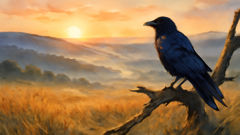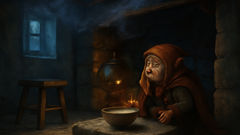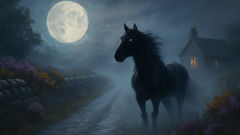Introduction
On the edge of a fjord where spruce trees lean toward the water and the wind keeps a steady watch over the barn roof, a small figure moves with a sure purpose in the long Norwegian dusk. He is only a few hands tall, with a beard that carries the scent of rain and pine, and eyes that gleam like frost on a window. He has no need for grand proclamations, yet when the stove is cold and the pigs grumble in their pens, his presence is a weather pattern all by itself, a reminder that a farm is a living pact shared between breath and soil. In the memory of the old families who settled these lands, the Nisse or Tomte is not a superstition but a neighbor who tends the garden while the family sleeps, who keeps pests away from the granaries and nudges the cattle toward balance when they balk at dawn. He arrives with snow in his hair and doubt in the heart of any farmer who forgets to greet him with thanks and to leave a bowl of warm porridge by the door, buttered with care, and a saucer of milk on the sill, facing north where the cold never truly ends. To tell this tale is to remind the reader that guardians come in small sizes and quiet manners, that a sturdy fence is not enough if the ground under it forgets to listen, and that a harvest belongs to those who honor the unseen as much as the visible. In the pages that follow, you will walk the muddy path between cabin and barn with a family who learns the ancient language of respect, who discover that a temper can be a forest fire in miniature, and who finally understand that the guardian will stay only as long as gratitude remains. The story unfolds with the cadence of a winter lullaby and the crackle of a stove that never quite warms the room without the blessing of a shared ritual. If you listen closely, you can hear the tread of hooves on frost, the sigh of hay in a loft, and the whisper of a tiny voice that asks not for reverence but for remembrance.
Section I: The Arrival and the Quiet Pact
The first signs arrive not with a shout but with the soft fall of a mug on the floor, the hedgehog of a mouse crossing the kitchen, and the little footprints that appear on a dusty step, as if someone had learned to walk with the tread of a farmer long after the last boot was shed. In the little valley where the land tilts toward the water, the family tends sheep and barley, and the days are long enough to tire a man and short enough to teach his wife and children how to listen. It is here that the Nisse makes his entrance not with fanfare but with a ritual of presence: a tin cup set at the edge of the kitchen threshold, a bowl of porridge stewing with thick cream, and a carved spoon that seems older than the house. At first the family laughs, thinking a neighbor has slipped into the story like a stray ghost, but the laughter thins as weeks pass and small misfortunes accumulate. Tools disappear in the early hours, goats refuse their milking, and the oven door becomes stubborn, a stubbornness that can only be explained by the stubborn will of a creature who has a mind for the farm and a temper quick as a fox. The father tries to explain that perhaps a gust of wind found its way under the door and rearranged the pantry, but the mother knows better. Her grandmother spoke of the North and the South wind, how each carries a message and a warning, how the land remembers kindness and returns it with a harvest fit to feed a household through the lean months. So the family begins to speak aloud to the unseen listener, to greet first, to apologize when a rule is broken, and to leave the bowl even when they are full of patience but short of time. The Nisse, small as a child and older than rumor, observes with a keen tilt of his hat and a pair of eyes that see into the heart before the heart has uttered its thought. When a storm comes and the river steals a fence post, it is not fear but gratitude that keeps the family steady, and the Nisse allows their fear to dissolve into a plan. He teaches by example, attending chores in the pale hours of morning, sharpening the oats for the horses with a careful breath, and warding off the weevils by spinning a quiet, protective whirl around the granary. The section ends not with a triumph but with a sigh of relief, as the porch light glows and the small guardian sits briefly atop the mossy stone by the door, a sentinel who has chosen to stay only if respect remains alive in the daily rhythms of the farm.
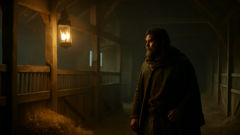
Section II: The Temper and the Trial
The calm does not harden into certainty but rather becomes a patient surface over a current that can shift with a cry or a careless word. The first real trial comes when a harvest is due, when the granary hums with the promise of bread and the family, bruised by a winter that never seems to end, rushes to finish the last tasks before a week of market buying and school lessons refract their routine into something brisk and practical. In the late afternoon, a quarrel is born, not loud but sharp, between a father who wants efficiency and a guardian who wants to be treated as a participant in the life of the house. A plate is knocked aside in anger, a cat darts from the doorway, and the door slams with a sound that travels through plank and bone, as though the house itself could feel insult. The days that follow are a sequence of small misfortunes: the cows stumble at milking, the fence posts lean and crack, the kettle refuses to boil without a stubborn squeal, and the Ireland-wind outside seems to murmur a warning in a language no one speaks aloud. The Nisse is not cruel; he is precise. A temper is a lesson, he seems to think, and a lesson must be learned without a loud protest. The family begins to understand that respect is not a polite ritual but a daily discipline: a word spoken softly, a bowl offered without hesitation, a moment given to listen to the quiet voice that comes with the creak of a wooden floor and the sigh of a mare in pain. The turning point arrives on a night when the storm rattles the windows and the storm-tossed river gnaws at the bank. The father awakens with a start, a remembered vow, and a bowl of porridge left at the threshold as a confession of fault and a gift to repair the wrong. Then the other signs arrive with the morning light—tools returned to their places as if guided by a patient, unseen hand; the hens lining up for grain in the exact order you would expect if someone counted them in the dark; the dog that refuses to bark at a shadow because the shadow is now a friend. The temper of the Nisse remains, but it is tempered by a shared ritual that includes listening to the wind and hearing the land talk back. The family learns that the farm can prosper without fear if every corner of the home is tended with honesty, and that the guardian watches not to condemn but to remind them of the ground they stand on and the community they belong to.

Section III: Harmony Restored and a Trust Passed On
The last act is not a triumph sung in loud voices, but a slow, durable restoration of balance, a quiet trust that grows out of small choices repeated through seasons. The family finds a rhythm that honors both the earth and the guardian who has learned their names in a dozen languages of patience. They begin to convene at dusk for a moment of gratitude before the stove warms the room, and they keep an extra seat at the table for the Nisse, a place kept warm for the neighbor who cannot be seen but who is profoundly present. The Nisse no longer needs to announce his arrival with noise; he treads softly and comes when invited, his temper smoothing into a confiding warmth, a feeling that the work of the day belongs not only to the hands but to the shared memory of a people who understand that a pasture is a living thing and that a grandmother's tale is a protective spell. The harvest becomes a celebration not just of grain but of the bonds that bound the family to the land and to the unseen helper who guards their efforts. Dusk finds them walking in the fields, counting the stars as if each star were a signboard toward a future where young hands will learn to listen before they act, and old hands will teach them to speak with care. The Nisse, now well within the circle of care, reveals his true nature not as a fairy to be frightened but as a keeper of continuity, a reminder that history lives in the ordinary. When winter returns and spring seems springier because the barn is full, the village hears rumor of a guardian who travels between homes not with a cape but with a kettle and a story, a small figure who does not demand praise but asks for gratitude. The family passes the tale to their children, who greet the guardian with the same respectful bow their grandmother taught them, and the farm learns to thrive in a shelter of mutual respect, memory, and hard-won wisdom. The final lesson is simple: protect the land, honor the guardian, and your harvest will be a chorus rather than a whisper.
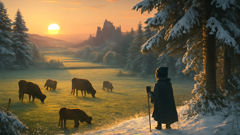
Conclusion
The legend closes with a single, enduring line that keeps repeating in the quiet after the stories are told: guardians live where gratitude is practiced. The Nisse does not vanish when the cold comes; he stays as long as there is room for the care that keeps a home whole. The family learns that the most powerful magic on a Norwegian farm is not the charm of a spell but the steady discipline of tending, speaking, and sharing with those who walk unseen paths beside them. In winter’s sleep and summer’s labor, the land remembers every act of kindness and returns it in harvest and health. The village inherits the practice of asking before acting and listening before speaking, of feeding the soil, feeding the story, and feeding the guardian of the old country with bowls of warm porridge and bread that smells of butter melted with patience. And when children ask about why the farm thrives, the elders tell the same patient tale: a small guardian with a big job, a temper that can scorch or soothe, and a family that chose to see him as a partner, not as a superstition. That choice made, the land offers what the people hoped for—a living memory that sings through the wind, a legend kept alive by daily kindness, and a future that will remember to listen long after the last candle has burned away.









